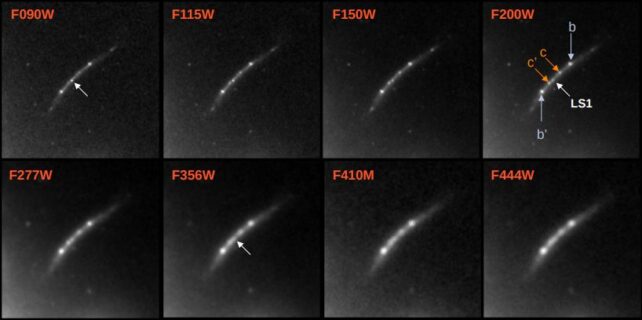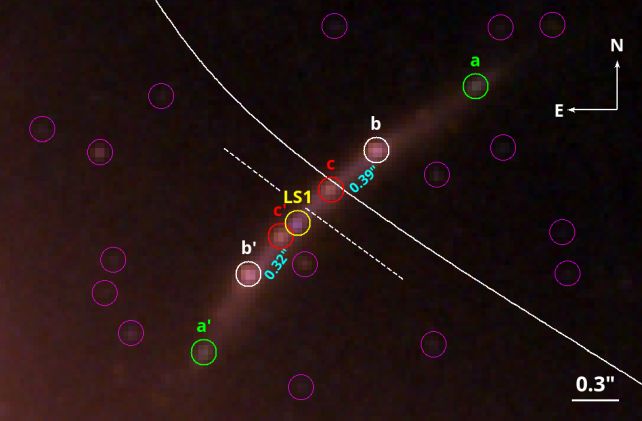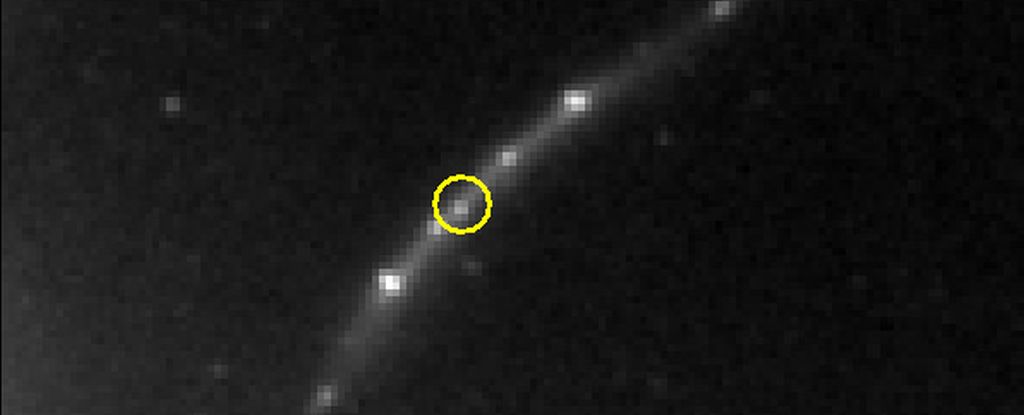Products You May Like
A newly discovered star is so large, bright, and strange that its appearance could be pointing us towards a clump of dark matter in the sky.
Named Mothra by its discoverers, it seems bizarrely bright in the sky, for the 10.4 billion years it has taken to reach us. This places it in the class of extremely rare “kaiju” stars: distant monster stars with anomalously huge apparent brightness, according to a team led by astrophysicist José Diego of the Spanish National Research Council in Spain.
The discovery has been detailed in a preprint paper published on arXiv.
One other star has been identified in this category, and it’s significantly brighter than Mothra. Its name is Godzilla, also discovered by Diego and colleagues, and it’s been identified as the most luminous known star in the sky.
Despite their differences, the two stars have some intriguing similarities that suggest massive blobs of dark matter are lurking in the space between us and them.
Diego and his team say this could be a probe that sets constraints on dark matter, which in turn could help us narrow down what dark matter actually is.

Mothra – more formally known as EMO J041608.8−240358 – was discovered in observations of the distant galaxy collected by the James Webb Space Telescope. Even JWST, as powerful as it is, would usually struggle to pick out individual stars over such vast gulfs of space and time; but the region of space is one that’s been strongly magnified by a gravitational lens.
These occur due to the curvature of space-time around a massive object in space, such as a galaxy or galaxy cluster. Any light traveling through that curved space-time can become distorted, duplicated, and magnified. This quirk of the cosmos, predicted by Einstein’s theory of general relativity, allows us to see more distant objects in much greater detail than their distance would usually allow.
Both Godzilla and Mothra are in sections of space that are warped by galaxy clusters between us and them. This provides some magnification, making the stars appear brighter. And they were bright objects to begin with.

The researchers scoured archival data from the Hubble Space Telescope, and found two observations that captured the star, taken six months apart in 2014.
By combining that data with the JWST data, the team was able to work out the properties of the star. According to the calculations of Diego and his colleagues, Mothra is probably a binary consisting of two supergiant stars, one red and one blue.
The red star is cooler and dimmer, around 5,000 Kelvin, with a luminosity of 50,000 Suns. The blue star clocks in at a much hotter 14,000 Kelvin, and a luminosity of around 125,000 Suns.
But what’s interesting is the magnification. The galaxy cluster alone can’t account for the magnification of Mothra, which the team found to be a factor of at least 4,000. There’s something closer to the star giving it an additional magnification boost.

With a little more number-crunching, the team found that, whatever that something is, it’s around the size of a dwarf galaxy or star cluster – between 10,000 and 2.5 million times the mass of the Sun. But we can’t see it; it just doesn’t appear in either the JWST or Hubble observations.
This suggests, the team says, that the object could be a dwarf galaxy almost entirely consisting of dark matter. Such an object is not unprecedented. Dark matter is the invisible glue of the Universe, and most galaxies have more dark matter than normal matter. And scientists have identified objects that seem to be mostly made of the mystery stuff.
The potential detection of the Godzilla and Mothra dark matter blobs, however, suggests that they may be relatively common in the Universe. And lensing could be the means we use to find them. This, in turn, could help place constraints on dark matter.
“The existence of this millilens is fully consistent with the expectations from the standard cold dark matter model,” Diego and his team write. “On the other hand, the existence of such a small substructure in a cluster environment has implications for other dark matter models.”
For example, it excludes the existence of warm dark matter and axion dark matter – two other theories – outside of a specific mass range. Future discoveries of kaiju stars could help narrow it down even further.
Perhaps the dark matter smoking gun will be a triple star system named Ghidorah.
The research appears on preprint server arXiv.
